Warship Wednesday, April 19, 2017: The busy year of the Raiders’ taxi service
Here at LSOZI, we are going to take off every Wednesday for a look at the old steam/diesel navies of the 1859-1946 time period and will profile a different ship each week. These ships have a life, a tale all their own, which sometimes takes them to the strangest places. – Christopher Eger
Warship Wednesday, April 19, 2017: The busy year of the Raiders’ taxi service
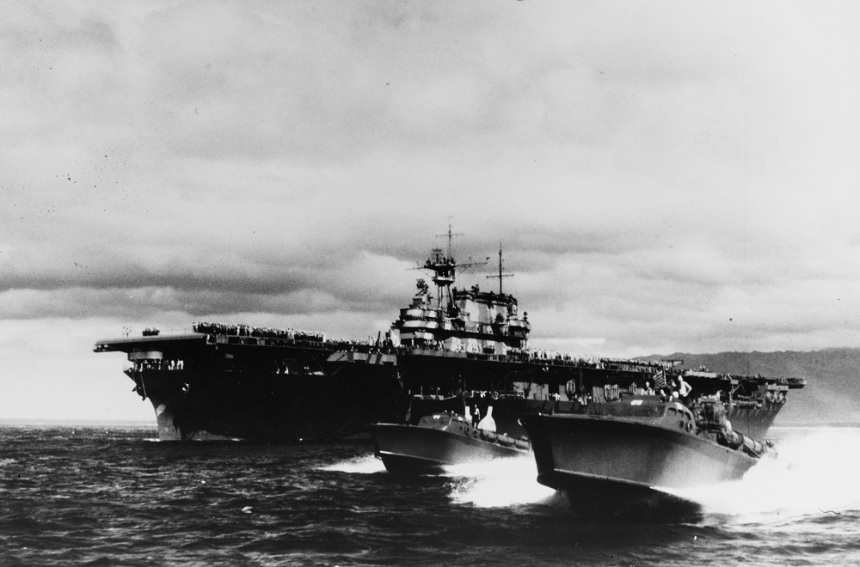
Official U.S. Navy Photograph, now in the collections of the U.S. National Archives. Catalog #: 80-G-16865
Here we see the Yorktown-class carrier, USS Hornet (CV-8), as she arrives at Pearl Harbor after the Doolittle Raid on Japan, 30 April 1942. Note PT-28 and PT-29 speeding by in the foreground. If this image doesn’t scream “war in the Pacific” nothing else does. It should be noted that this photo was taken 75 years ago this month.
Starting with the “covered wagon” that was the converted collier USS Langley, and moving through a pair of huge converted battlecruisers USS Lexington and Saratoga, and the Navy’s first flattop designed from the keel up, USS Ranger, gave the Navy four lessons learned over a 15-year period in carrier design and development which led to the Yorktown class.
Designed in the early 1930s, these 19,800-ton vessels (26,000 fl) were nice floating landing strips some 824-feet long. Equipped with two catapults on the flight deck and a (useless) hangar deck level cat, these straight deck carriers featured three elevators and could accommodate a 90-plane air wing. Fast, at 32.5-knots, they could outstrip submarines and most battleships of the era, and a smattering of 5″/38, 1.1″/75 quads, and water-cooled Browning .50 cals provided defense against 1930s-era small surface combatants and planes. With long legs (12,500nm at 16 knots) they could travel the Pacific or Atlantic with ease and minimal tanker support.
Class leader, Yorktown (CV-5), was laid down in 1934 and made it to the fleet three years later, followed by the famous Enterprise (CV-6). The subject of our tale was the 7th USS Hornet on the Navy List and, like her two sisters was laid down at Newport News.
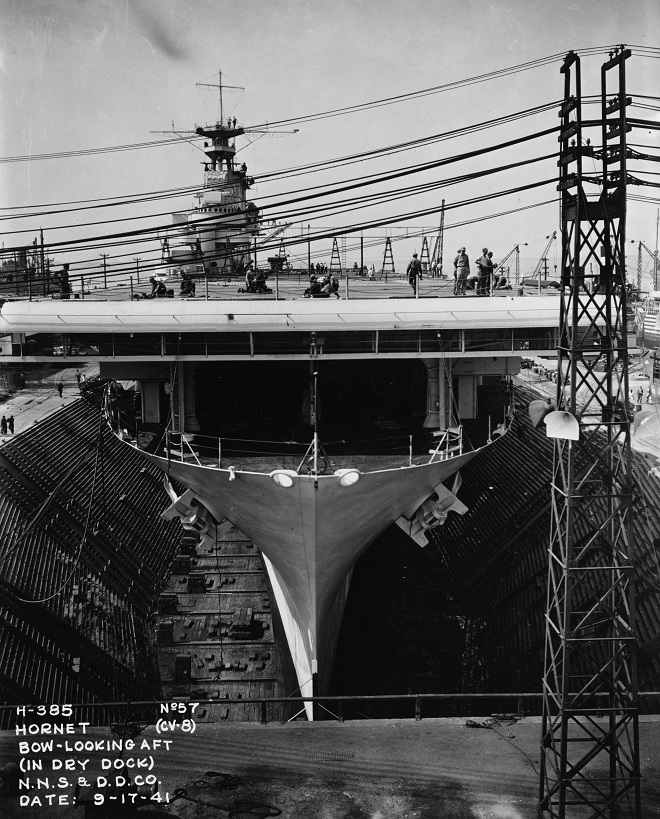
USS HORNET (CV-8) View taken while in drydock at Newport News Shipbuilding & Drydock Co., Virginia, from directly ahead, while in process of completion. View taken on 17 September 1941. Paint scheme appears to be peacetime “haze gray.” Catalog #: 19-N-26389
Hornet was commissioned 20 October 1941, two years after the rest of the world entered WWII and two months before the United States did the same. Her first commander was a scrappy fellow by the name of Captain Marc A. Mitscher.
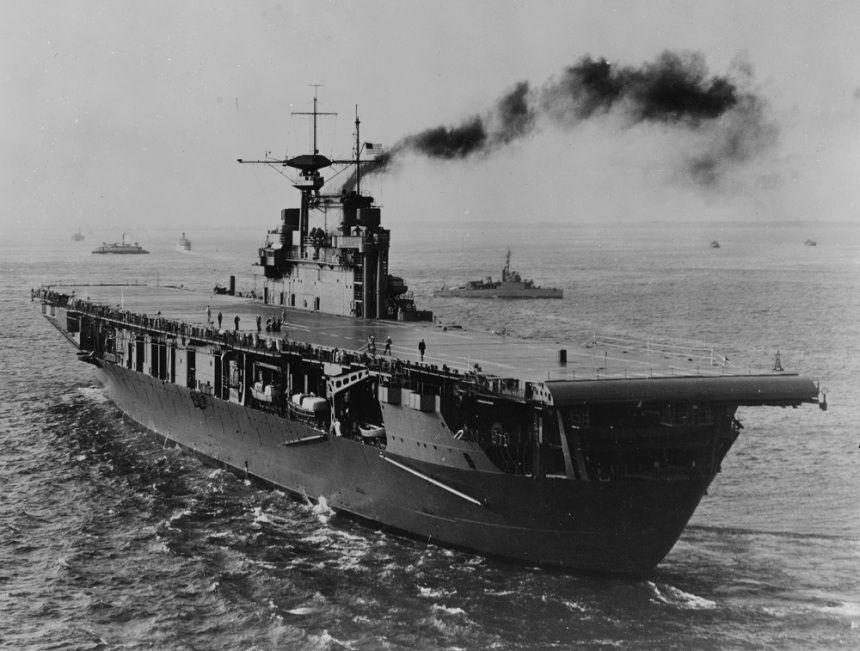
USS Hornet (CV-8) Photographed circa late 1941, soon after completion, probably at a U.S. east coast port. A ferry boat and Eagle Boat (PE) are in the background. Catalog #: NH 81313
When the Japanese hit Pearl Harbor, Hornet was in Norfolk but was made ready for war in the Pacific, losing her .50cals in exchange for Oerlikon 20mm guns and picking up a camo scheme.
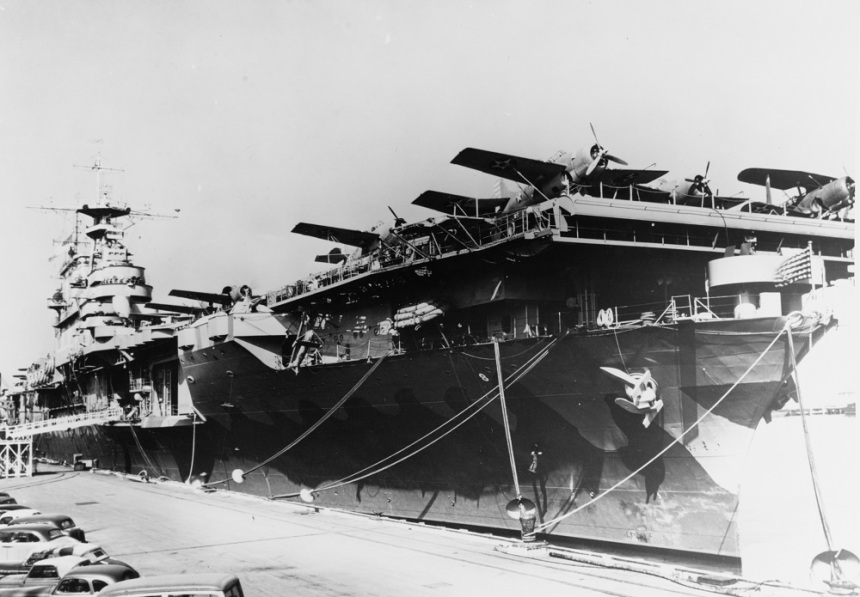
USS HORNET (CV-8) At Pier 7, Naval Operating Base, Norfolk, Virginia, in February 1942. Planes visible in foreground at the forward end of the flight deck are Grumman F4F-4s (VF-8) and a Curtiss SBC-4 from either VS-8 or VB-8. Note rat guards on lines in the foreground. Catalog #: 19-N-28429
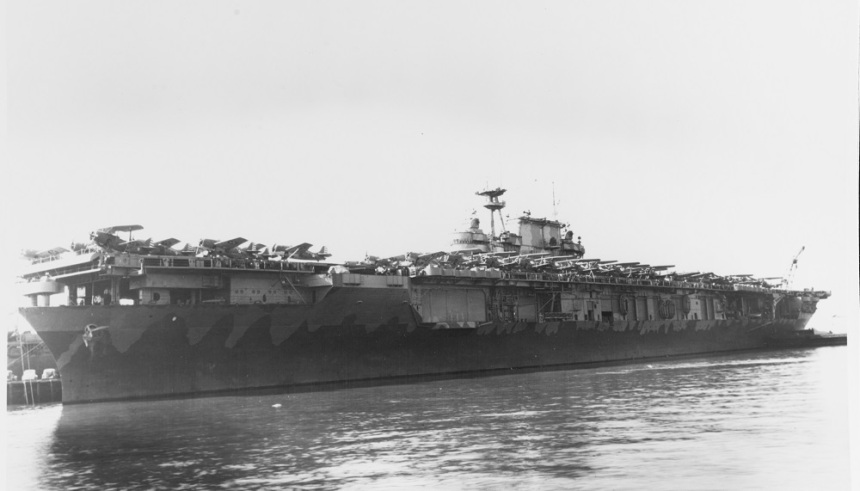
USS HORNET (CV-8) View taken while alongside Pier 7, Naval Operating Base, Norfolk, Virginia, in February 1942, prior to her departure for the war zones. Her air group consists of Grumman F4F-4s (VF-8), Curtiss SBC-4s (VS-&VB-8) and Douglas TBD-1s (VT-8). Camouflage on ship is measure 12 (MOD.) Catalog #: 19-N-28431

USS HORNET (CV-8) Broadside view of amidships, at Naval Operating Base Norfolk, Virginia, in February 1942. Plane types visible on deck: Douglas TBD-1 (VT-8), Grumman J2F-5 (utility unit), Curtiss SBC-4 (VS-or VB-8) and Grumman F4F-4 (VF-8). Note Meas .12 (Mod.) camouflage; and cars on the pier. Catalog #: 19-N-28432
It was at Norfolk that she tested flight deck operations with a trio of Army B-25 medium bombers, and found they could be launched successfully with a degree of pucker– and even landed with a greater one.
“Take-off and landing tests conducted with three B-25B’s at and off Norfolk, Virginia, indicated that take off from the carrier would be relatively easy but landing back on again extremely difficult.” said Lieutenant Colonel James H. Doolittle in his report to the commanding general of Army Air Forces. “It was then decided that a carrier take-off would be made some place East of Tokyo, and the flight would proceed in a generally westerly direction from there. Fields near the East Coast of China and at Vladivostok were considered as termini.”
Then came a transfer to the West Coast, and a special mission for the carrier still technically on shakedown.
Arriving in San Francisco, Hornet had part of her Naval airwing offloaded and 16 Army B-25s, 64 modified 500-pound bombs, and 201 USAAF aviators and ground crew transferred aboard.
Putting to sea on April 2, the task force commanded by Vice Adm. Halsey consisted of Hornet with her escort Nashville, the carrier Enterprise with her three companion heavy cruisers Salt Lake City, Northampton, and Vincennes, as well as a group of destroyers and tankers headed West for points unknown and under great secrecy.
After refueling from the tankers on April 17, the four cruisers and two carriers raced towards Japan. The plan was to launch the first raid on the Home Islands to score a propaganda victory following a string of defeats across the Pacific in the first four months of the war.
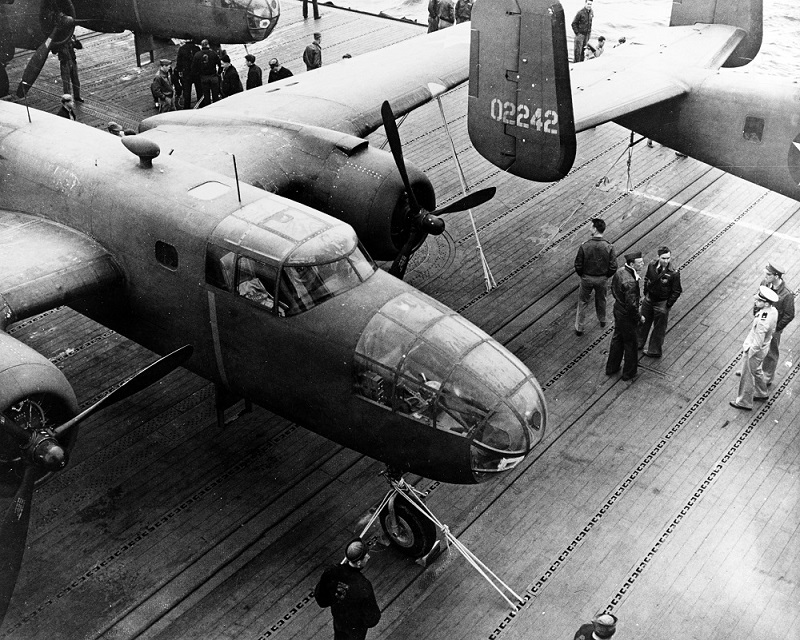
Army Air Forces B-25B bombers parked on the flight deck of USS Hornet (CV-8), while en route to the mission’s launching point. The plane in the upper right is tail # 40-2242, mission plane # 8, piloted by Captain Edward J. York. Note the use of the flight deck tie-down strips to secure the aircraft. The location is near the forward edge of the midships aircraft elevator. Catalog #: NH 53296
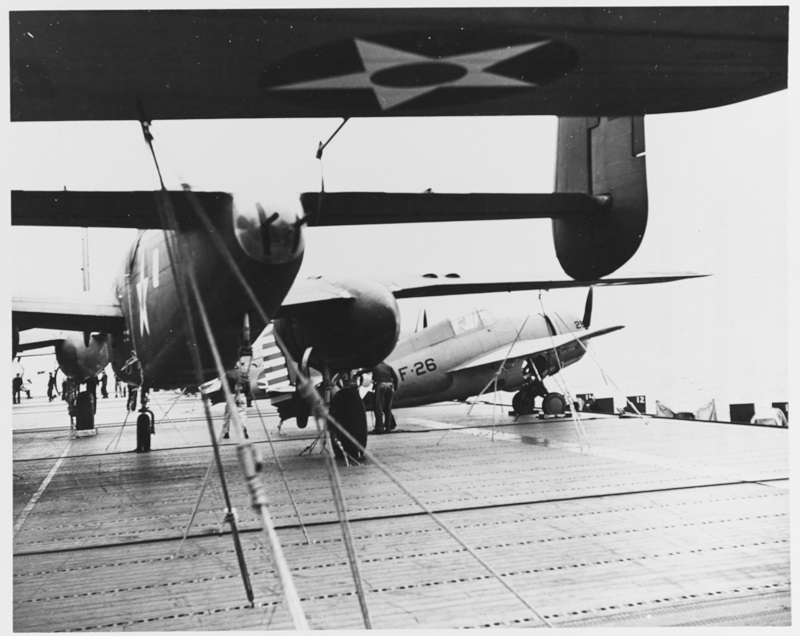
USAAF B-25B bombers and Navy F4F-3 fighters on the flight deck of USS Hornet (CV-8), while she was en route to the mission’s launching point. Note wooden dummy machine guns in the tail cone of the B-25 at left. Catalog #: NH 53422
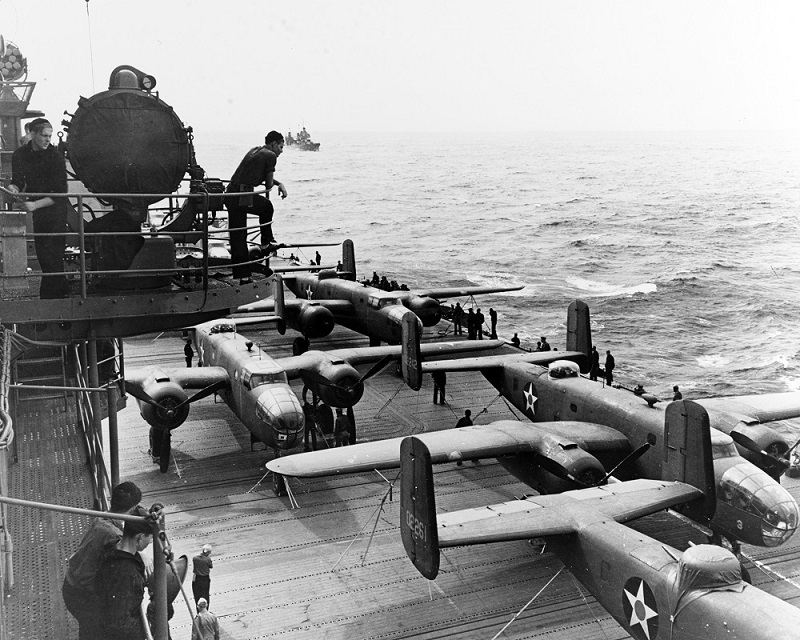
Doolittle Raid on Japan, 18 April 1942 View looking aft and to port from the island of USS Hornet (CV-8), while en route to the mission’s launching point. USS Vincennes (CA-44) is in the distance. Several of the mission’s sixteen B-25B bombers are visible. That in the foreground is tail # 40-2261, which was mission plane # 7, piloted by 2nd Lieutenant Ted W. Lawson. The next plane is tail # 40-2242, mission plane # 8, piloted by Captain Edward J. York. Both aircraft attacked targets in the Tokyo area. Lt. Lawson later wrote the book Thirty Seconds over Tokyo. Note searchlight at left. Catalog #: NH 53293
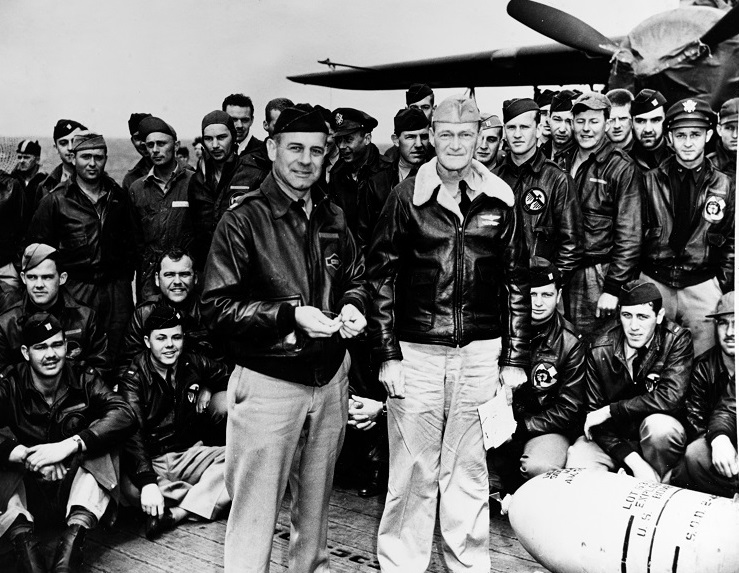
Lieutenant Colonel James H. Doolittle (left front), leader of the attacking force, and Captain Marc A. Mitscher, Commanding Officer of USS Hornet (CV-8), pose with a 500-pound bomb and USAAF aircrew members during ceremonies on Hornet’s flight deck, while the raid task force was en route to the launching point. Catalog #: NH 64472
However, the group was sighted while still far out to sea. The quick-shooting Nashville rapidly engaged the Japanese ship, Gunboat No. 23 Nittō Maru, and sank her with 6-inch shells, but the little 70-ton boat got off a warning via radio on her way down.
The 16 bombers quickly launched into history and the six ships of the task force turned back for safer waters.
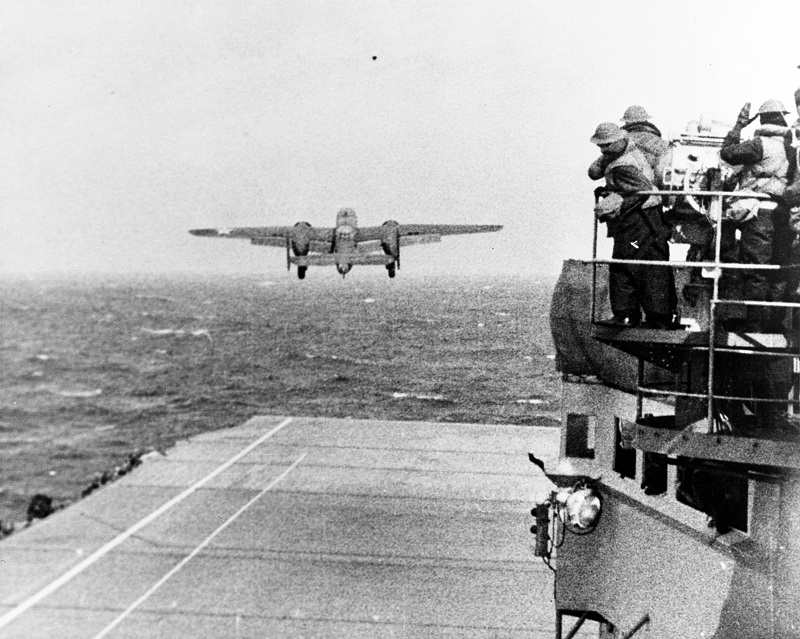
An Army Air Force B-25B bomber takes off from USS Hornet (CV-8) at the start of the raid, 18 April 1942. Note men watching from the signal lamp platform at right. Official U.S. Navy Photograph, now in the collections of the National Archives. Catalog #: 80-G-41196
As noted by DANFS:
As Hornet swung about and prepared to launch the bombers which had been readied for take-off the previous day, a gale of more than 40 knots churned the sea with 30-foot crests; heavy swells, which caused the ship to pitch violently, shipped sea and spray over the bow, wet the flight deck and drenched the deck crews. The lead plane, commanded by Colonel Doolittle, had but 467 feet of flight deck while the last B-25 hung far out over the fantail. The first of the heavily-laden bombers lumbered down the flight deck, circled Hornet after take-off, and set course for Japan. By 0920 all 16 of the bombers were airborne, heading for the first American air strike against the heart of Japan.
Hornet brought her own planes on deck and steamed at full speed for Pearl Harbor. Intercepted broadcasts, both in Japanese and English, confirmed at 1445 the success of the raids. Exactly one week to the hour after launching the B-25s, Hornet sailed into Pearl Harbor. Hornet’s mission was kept an official secret for a year; until then President Roosevelt referred to the origin of the Tokyo raid only as “Shangri-La.”
Three Raiders died trying to reach safety in China. Japanese soldiers executed three. One died in captivity.
However, Hornet was not allowed to rest on her laurels and soon set off to meet the Japanese in the Coral Sea, but arrived just after the pitched battle that saw the loss of the giant USS Lexington.
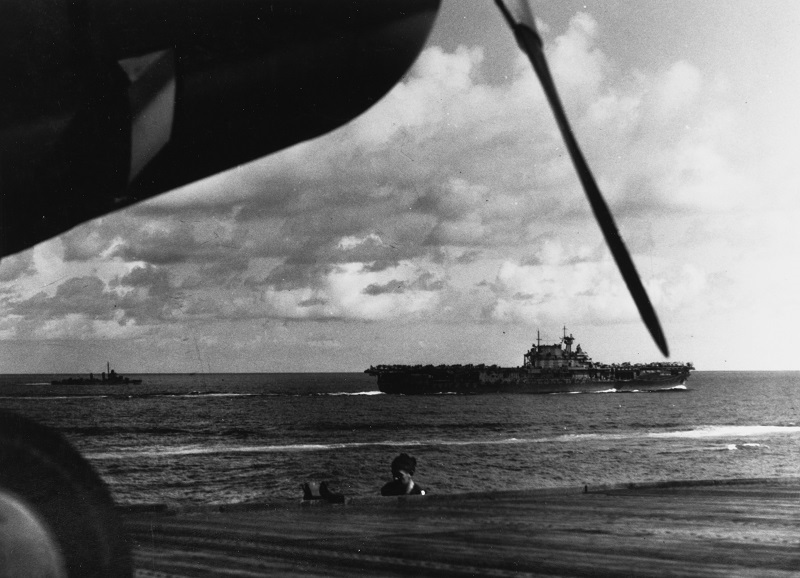
USS HORNET (CV-8) Steaming in the coral sea area, 13 May 1942. Photographed from USS ENTERPRISE (CV-6). Catalog #: 80-G-16430
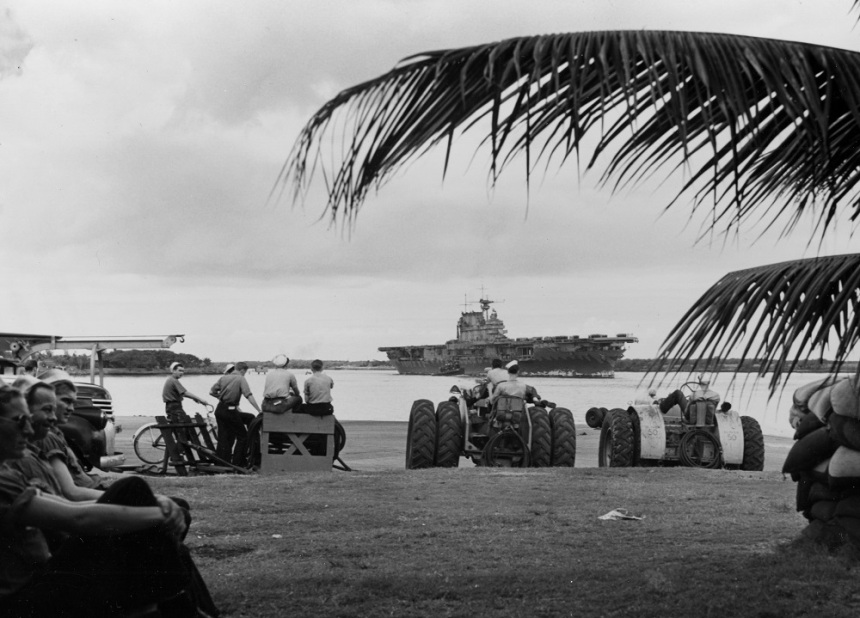
USS Hornet (CV-8) Enters Pearl Harbor, 26 May 1942. She left two days later to take part in the Battle of Midway. Photographed from Ford Island Naval Air Station, with two aircraft towing tractors parked in the center foreground. Catalog #: 80-G-66132
Then came Midway, where the now seven-month-old Hornet joined her sisters Yorktown and Enterprise to blunt Yamamomo’s greatest effort.
On 4 June, the combined torpedo plane fleet of the three carriers made a charge of the light brigade style attack on the Japanese task force. Of the 41 TBD Devastators that took off that day, 15 were from Hornet‘s Torpedo Squadron Eight (VT-8). However, they were jumped by Japanese fighters eight miles from their targets and all 15 were shot down. Only one pilot, Ens. George H. Gay, USNR, reached the surface as his plane sank and hid under a rubber seat cushion while he watched the dive bombers come in and get revenge in the sinking of four Japanese carriers, turning the tide of the war
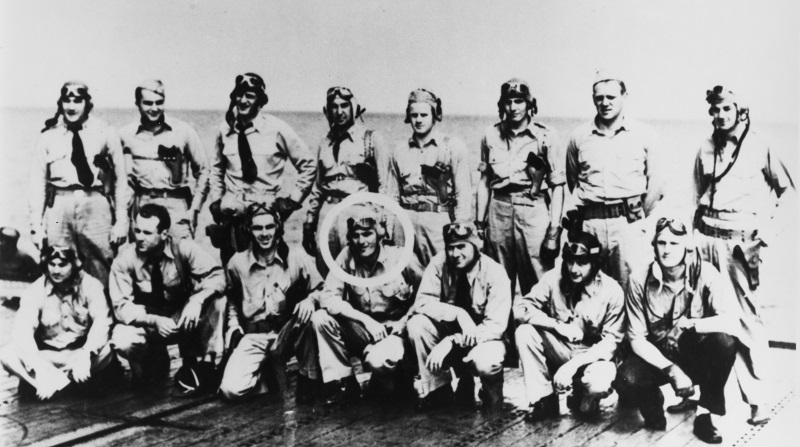
Torpedo Squadron Eight (VT-8) Pilots Photographed on board USS Hornet (CV-8), circa mid-May 1942, shortly before the Battle of Midway. They are Ensign Harold J. Ellison; Ensign Henry R. Kenyon; Ensign John P. Gray; Ensign George H. Gay, Jr. (circled); Lieutenant (Junior Grade) Jeff D. Woodson; Ensign William W. Creamer; Aviation Pilot First Class Robert B. Miles. Lieutenant James C. Owens, Jr.; Ensign E.L. Fayle; Lieutenant Commander John C. Waldron, Squadron Commanding Officer; Lieutenant Raymond A. Moore; Ensign Ulvert M. Moore; Ensign William R. Evans; Ensign Grant W. Teats; Lieutenant (Junior Grade) George M. Campbell. Courtesy of the U.S. Naval Institute, Annapolis, MD. U.S. Naval History and Heritage Command Photograph. Catalog #: NH 93595
Two days later, to add the ending period to the battle, Hornet‘s planes attacked the fleeing Japanese fleet to assist in sinking cruiser Mikuma, damaged a destroyer, and left cruiser Mogami aflame and heavily damaged.
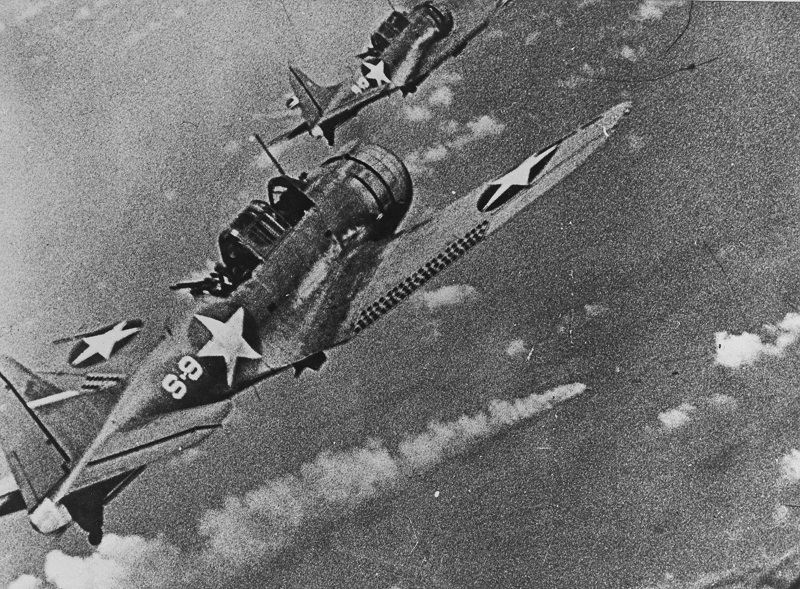
Battle of Midway, June 1942. SBD Dauntless dive bombers from USS Hornet (CV-8) approaching the burning Japanese heavy cruiser Mikuma to make the third set of attacks on her, during the early afternoon of 6 June 1942. Mikuma had been hit earlier by strikes from Hornet and USS Enterprise (CV-6), leaving her dead in the water and fatally damaged. The photo was enlarged from a 16mm color motion picture film. Note bombs hung beneath these planes. Catalog #: 80-G-17054
War artist Tom Lea shipped out on Hornet for her next run across the Pacific after Midway. There, in fierce service off Guadalcanal in late summer 1942, he spent more than two months on a front-line carrier in the thick of the war and sketched as he found, including the loss of the carrier Wasp.
From a six-week period from mid-September until 24 October, Hornet was the only operable U.S. carrier in the Pacific, all the others being either in repair or at the bottom.
On 26 October, joined by the newly patched up Enterprise, Hornet was involved in the Battle of Santa Cruz Island. During that sharp engagement often forgotten to military history, Hornet‘s airwing severely damaged the Japanese carrier Shokaku, delivering at least three (and possibly as many as six) 1,000-lb. bomb hits from the 15 Douglas SBD-3 dive bombers launched from our carrier, putting her out of service for months. Hornet‘s planes also made hay of the cruiser Chikuma.
However, just 371 days after she was commissioned, Hornet took extreme damage in return from Japanese torpedo and bomber aircraft.
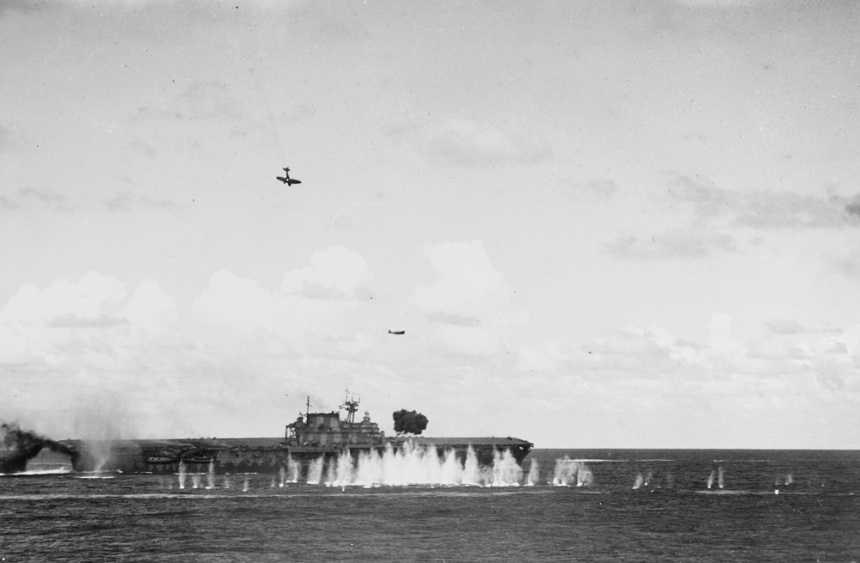
A Japanese Type 99 shipboard bomber (Allied codename Val) trails smoke as it dives toward USS Hornet (CV-8), during the morning of 26 October 1942. This plane struck the ship’s stack and then her flight deck. A Type 97 shipboard attack plane (Kate) is flying over Hornet after dropping its torpedo, and another Val is off her bow. Note anti-aircraft shell burst between Hornet and the camera, with its fragments striking the water nearby. Catalog #: 80-G-33947

Crew members of USS Hornet (CV-8) prepare to abandon ship on 26 October 1942, after she was disabled by Japanese air attacks. Photographed from USS Russell (DD-414). Note radar antennas on the carrier’s masts and gun directors, and other details of the ship’s island and port side. Radar antennas include those for FD types mounted atop the two Mark 37 gun directors at the island ends, a CXAM atop the foremast and a smaller radar (presumably an SC) partially visible atop the after mast. Catalog #: 80-G-34110
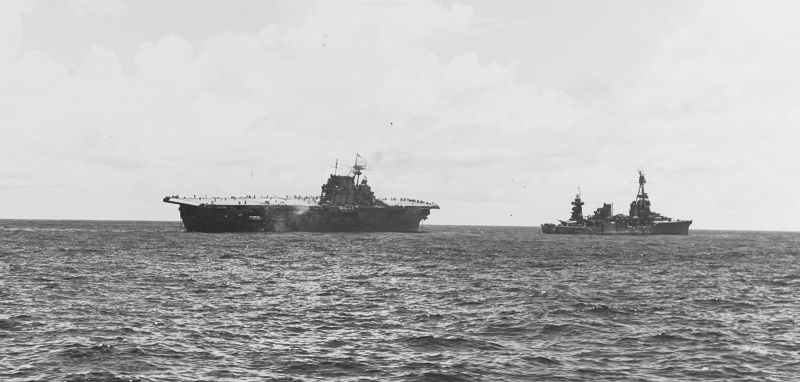
Battle of the Santa Cruz Islands, October 1942 Description: USS Northampton (CA-26), at right, attempting to tow USS Hornet (CV-8) after she had been disabled by Japanese air attacks on 26 October 1942. Catalog #: 80-G-33897
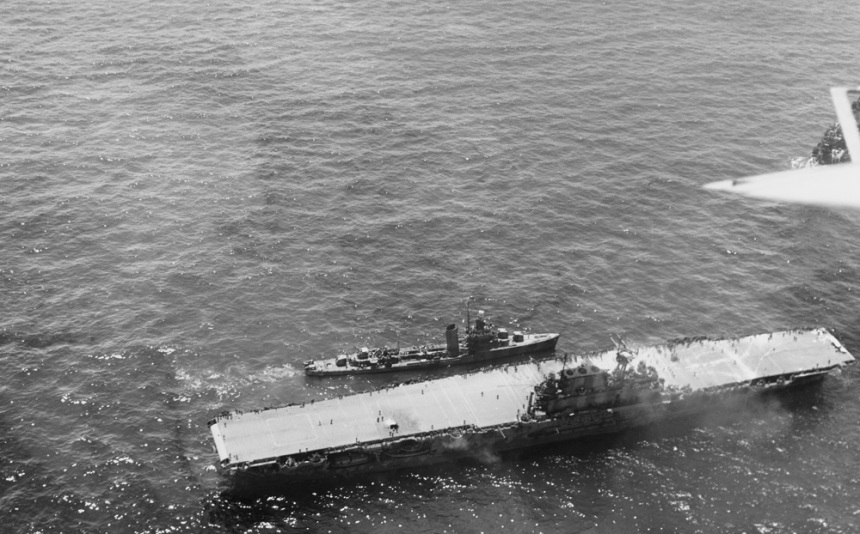
USS HORNET (CV-8) dead in the water with a destroyer alongside, 26 October 1942. Description: Catalog #: 80-G-304514
As noted by DANFS
The abandoned Hornet, ablaze from stern to stern, refused to accept her intended fate from friends. She still floated after receiving nine torpedoes and more than 400 rounds of 5-inch shellfire from destroyers Mustin and Anderson. Japanese destroyers hastened the inevitable by firing four 24-inch torpedoes at her blazing hull. At 0135, 27 October 1942, she finally sank off the Santa Cruz Islands. Her proud name was struck from the Navy List 13 January 1943.
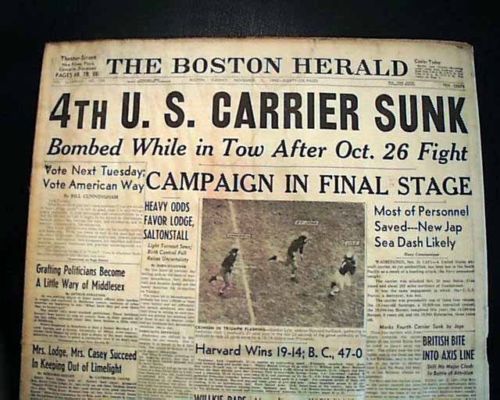
Boston Herald sinking of USS Hornet (CV-8), fourth US carrier sunk in WWII, the first three were Lexington (CV-2), Yorktown (CV-5), and Wasp (CV-7).
Tom Lea remembered the ship fondly.
On 21 October, just six days before she was to sink, he left the Hornet, pulling away on a fleet oiler that would land him back at Pearl Harbor. The cleared sketches he produced above would appear in LIFE in March and April 1943, sadly, after the carrier had long been sunk.
Back at Pearl Harbor, Lea showed Admiral Nimitz some of his drawings. One of them was the one above. Underneath the drawing, he inscribed a quotation from Deuteronomy: “Moreover the Lord thy God shall send the hornet among them, until they that are left, and hide themselves from thee, be destroyed.”
Admiral Nimitz looked at the drawing for a long time, then turned his head to Lea, and said: “Something has happened to the Hornet.”
That was how Lea found out that the aircraft carrier he had been on, together with his friends, perished.
This he immortalized in a painting ran by LIFE of how he pictured the ship going out– fighting.
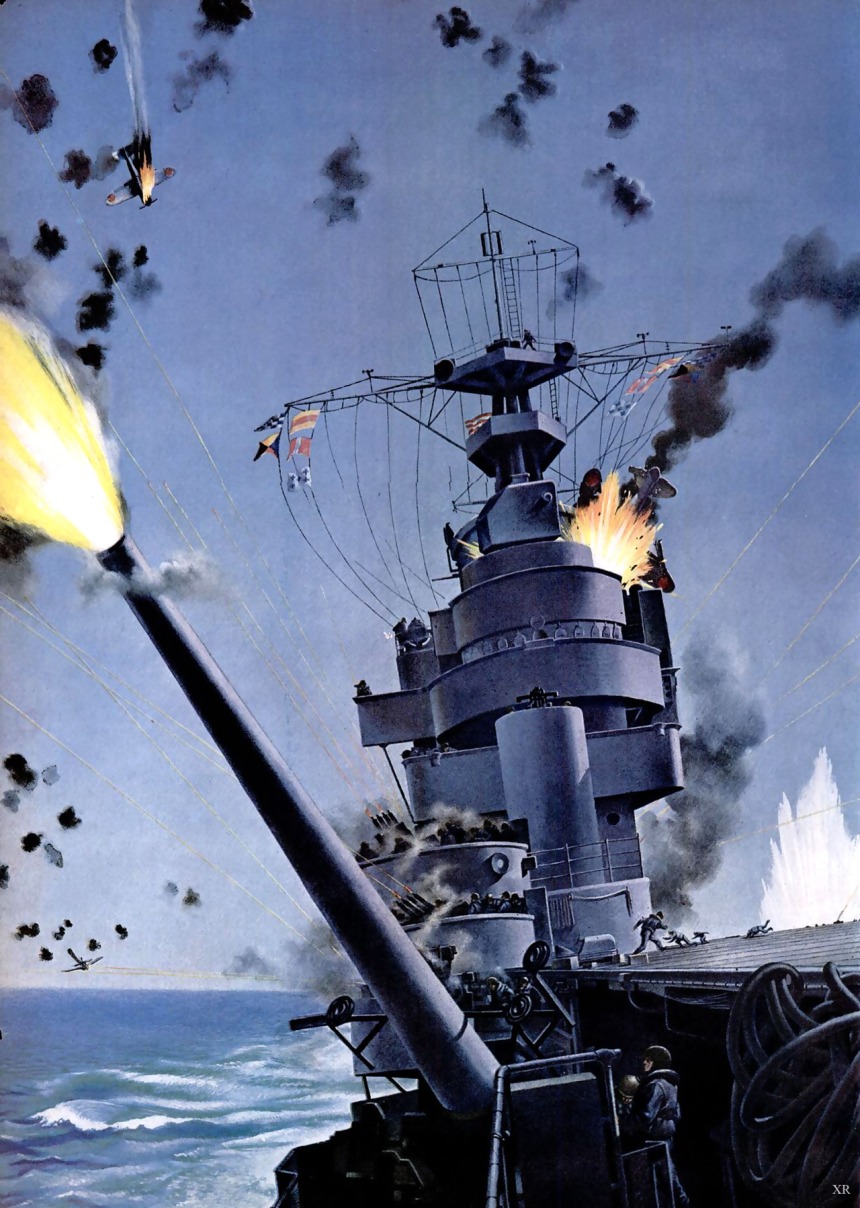
“An aircraft carrier is by her very nature a very peculiar warship, for she belongs not wholly to the sea nor sufficiently to the sky.” “Without heavy deck guns or stout armor, she is physically the most vulnerable of warships, carrying within her the seeds of her own destruction. Whenever she goes to sea she is loaded with bombs, shells and high-octane gasoline, all concealed behind her thin steel plates. ”
“Such a ship was the Hornet. She feared bombs, but also know that probably only torpedoes would sink her.”
“There is no way to describe how terrible a torpedo seems as it heads for a carrier. It leaves a strange wake, a rather thin, white, bubbly line like fluid ice, cold as the death is presages. Against the ship’s side, it explodes with an appalling concussion and a wild flash of pink flame. Within the ship, there is a terrible wrenching. Decks and bulkheads are twisted like tissue paper, and all things not secured by iron bolts are smashed.”
“The Hornet died under a moonlit sky on a shining tropical sea. She had been hit by two waves of Jap planes, the first in the morning, the second in the afternoon… Then came the last order: ‘Abandon ship.’ The men went over the side on knotted lines, down to life rafts, to floating debris, or simply to the water.”
“Behind them, their ship died a smoking death.”
“The great carrier was not alone. She had destroyers and cruisers with her, and they aided in the work of hauling the Hornet’s crew from the sea. In a few hours, it was all over. Those whose fate it was to live were alive, and those who had to die were dead.”
“A tropical sunset colored the hulk of the carrier and the stars came out faintly. After dark, she went down.”
-LIFE Magazine, “HORNET’S LAST DAY: Tom Lea paints death of a great carrier”
Hornet remains a favorite subject of maritime art, not just from Lea, but other painters. Take for instance this great piece by Gordon Grant.
Remember VT-8’s Ensign Gay? The lone survivor of his squadron survived the war, ending his service as a Lt. CDR and Navy Cross holder. In 1994 he died of a heart attack at a hospital in Marietta, Georgia, age 77, was cremated and his ashes spread at the place that his squadron had launched its ill-fated attack
As for the Raiders, the 75th anniversary of the Doolittle Raid on Tokyo was commemorated by the ceremonial arrival of 11 B-25 bombers at the National Museum of the United States Air Force at Wright-Patterson AFB, Ohio, on 17 April 2017, who flew in formation on the anniversary on Tuesday.
As noted by the AP, the last Raider living is 101-year-old retired Lt. Col. Richard “Dick” Cole. He attended Tuesday’s service at the National Museum of the U.S. Air Force near Dayton. Lead plane co-pilot Cole came from his Comfort, Texas, home.
The Navy still considers the Doolittle Raid to have relevent principals today.
“The Doolittle Raid, some 75 years ago, pushed Air Force Bombers outside of their normal operating envelope,” said Capt. Kevin Lenox, commanding officer of USS Nimitz (CVN 68), a World War II-namesake ship. “They were designed to fly from an airfield, but USS Hornet provided the perfect mobile launch point to send them into combat from the sea. The Navy didn’t have planes that could reach Tokyo, and the Air Force didn’t have any runways close enough. Together, their integrated capabilities were able to win the day, and that lesson has carried forward to today’s highly capable joint force.”
Specs:
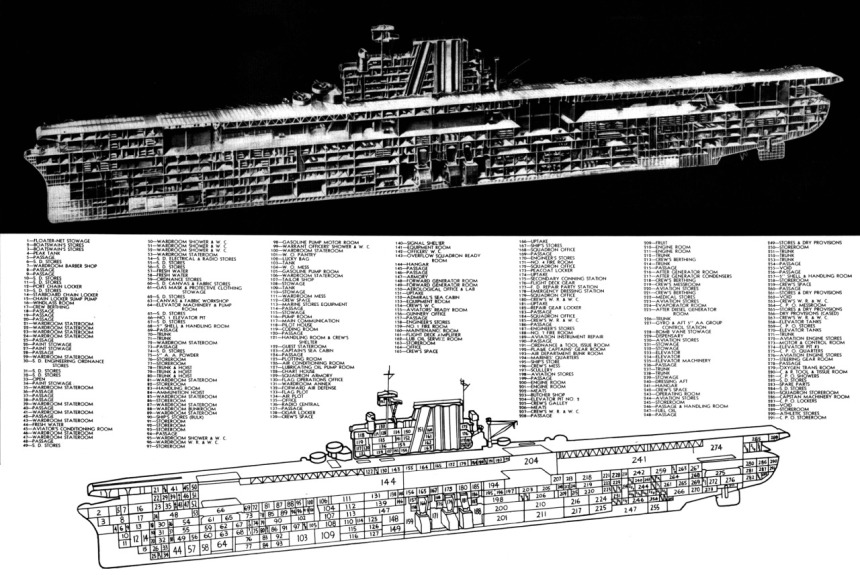
Displacement:
20,000 long tons (20,000 t) (standard)
25,500 long tons (25,900 t) (full load)
29,114 long tons (29,581 t) (maximum)
Length:
770 ft. (230 m) (waterline at design draft)
824 ft. 9 in (251.38 m) (overall)
Beam:
83 ft. 3 in (25.37 m) (waterline)
114 ft. (35 m) (overall)
Draft:
24 ft. 4 in (7.42 m) design
28 ft. (8.5 m) full load
Installed power: 120,000 shp (89,000 kW)
Propulsion:
4 × Parsons geared steam turbines
9 × Babcock & Wilcox boilers
Speed:
32.5 kn (37.4 mph; 60.2 km/h) (design)
33.84 kn (38.94 mph; 62.67 km/h) (builder’s trials)
Range: 12,500 nmi (14,400 mi; 23,200 km) at 15 kn (17 mph; 28 km/h)
Complement: 2,919 officers and enlisted (wartime)
Armament: (as built)
8 × 5 in (127 mm)/38 cal dual purpose guns
16(4×4) × 1.1 in (28 mm)/75 cal anti-aircraft guns
24 × M2 Browning .50 in (12.7 mm) machine guns
Armament (by July 1942)
8 × 5 in (127 mm)/38 cal dual purpose guns
20 (5×4) × 1.1 in (28 mm)/75 cal anti-aircraft guns
32 × 20-mm Oerlikon anti-aircraft cannon
Armor:
Belt: 2.5–4 in (63.5–102 mm)
Deck: 4 in (102 mm) 60 lb. STS steel
Bulkheads: 4 in (102 mm)
Conning Tower: 4 in (100 mm) sides, 2 in (51 mm) top
Steering Gear: 4 in (102 mm)
Aircraft carried: 72-90 × aircraft
Aviation facilities:
3 × elevators
3 × hydraulic catapults (2 flight deck, 1 hangar deck– latter removed 1942)
If you liked this column, please consider joining the International Naval Research Organization (INRO), Publishers of Warship International
They are possibly one of the best sources of naval study, images, and fellowship you can find http://www.warship.org/membership.htm
The International Naval Research Organization is a non-profit corporation dedicated to the encouragement of the study of naval vessels and their histories, principally in the era of iron and steel warships (about 1860 to date). Its purpose is to provide information and a means of contact for those interested in warships.
With more than 50 years of scholarship, Warship International, the written tome of the INRO has published hundreds of articles, most of which are unique in their sweep and subject.
PRINT still has its place. If you LOVE warships you should belong.
I’m a member, so should you be!
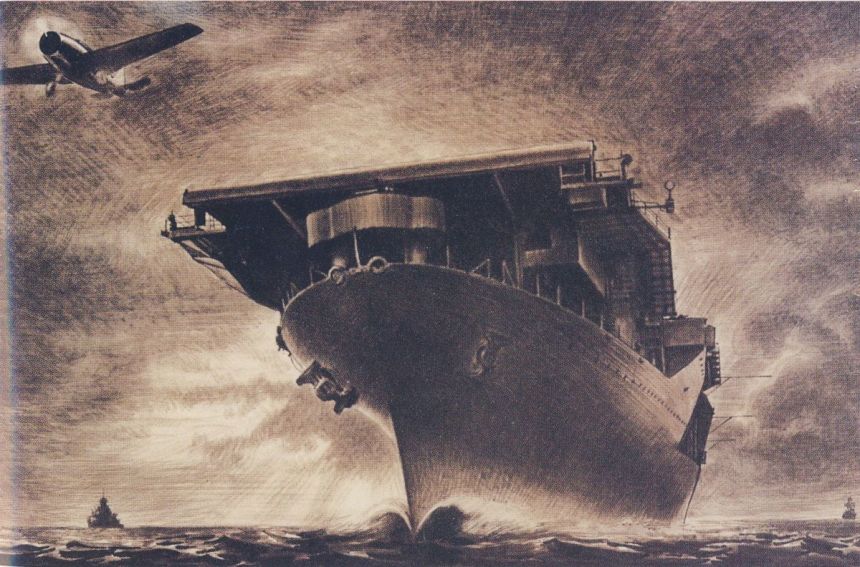
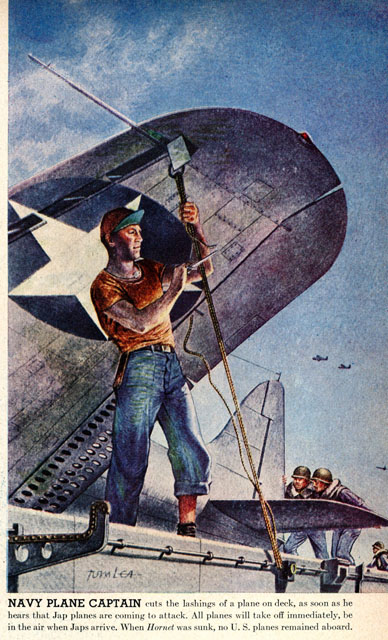

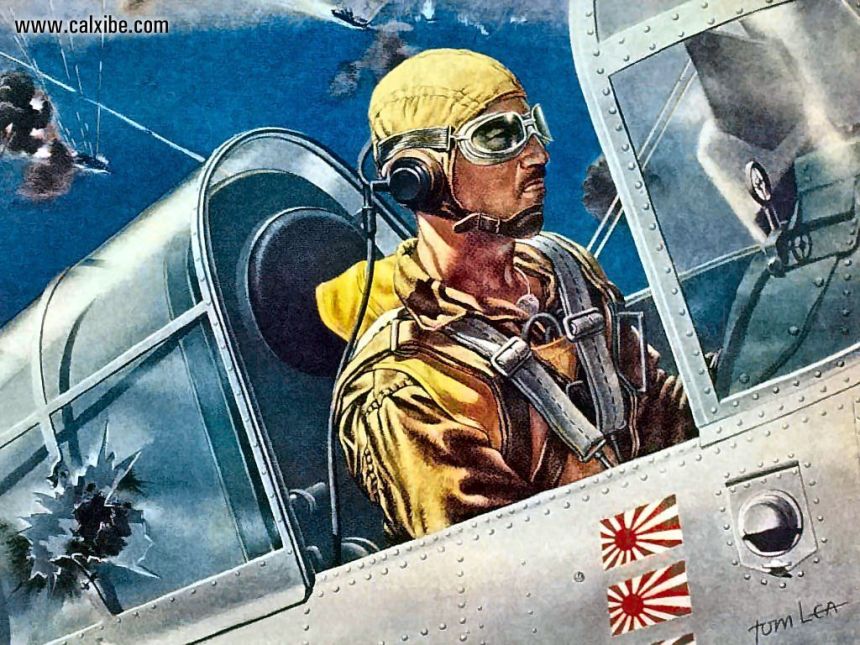
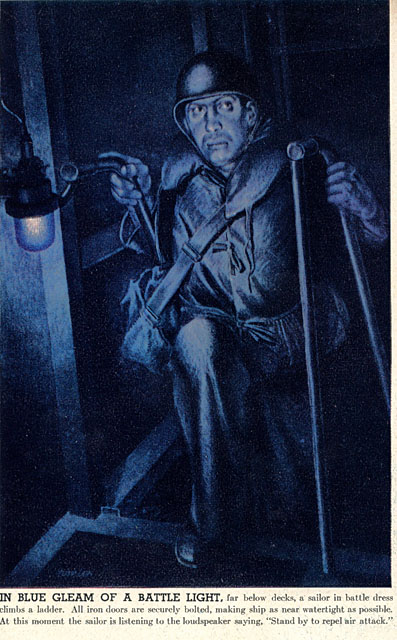
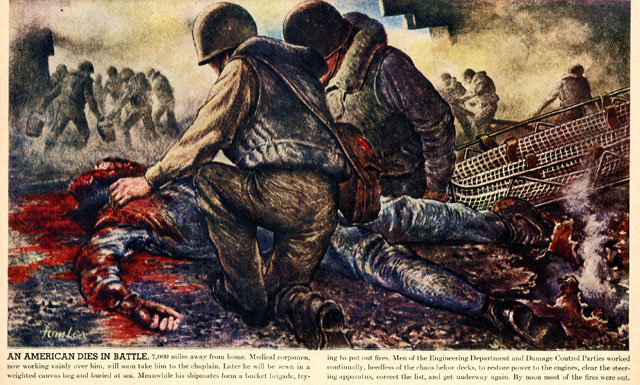
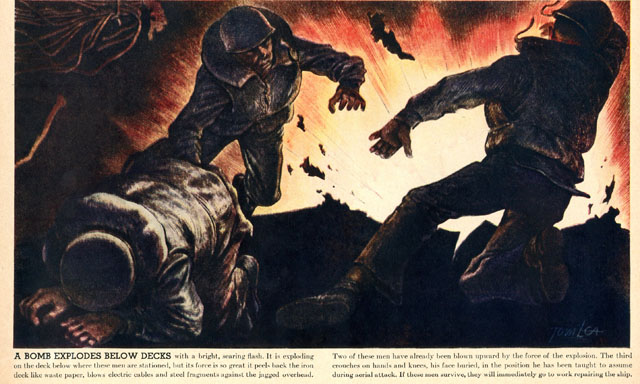
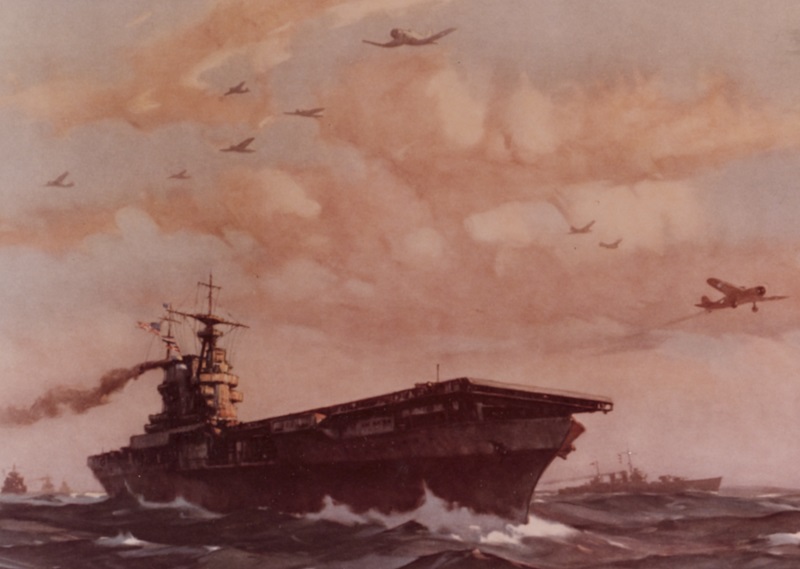
https://polldaddy.com/js/rating/rating.jsMy mothers oldest brother joined the USN in 1939 and was a plank owner on CV-8 USS Hornet. He was part of the flight deck crew. He witnessed the Doolittle raid, Midway and the ships final fight.
Pingback: Warship Wednesday, Oct. 13, 2021: Tokyo Express | laststandonzombieisland